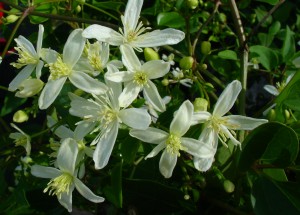
September on Nantucket is punctuated by a few really special plants. One of these is Clematis paniculata. Although this species of clematis does have a reputation for being somewhat aggressive, many gardeners consider it well worth the time spent pruning and tying.
Sweet Autumn Clematis bursts into growth in spring and will easily grow to cover a story-tall trellis in a season. It is beautiful trained along a fence, or up a pergola or down spout. Or let it sprawl along the ground in open areas as a ground cover. Plant it in full sun to part sun in average soil and this clematis will reward you with dark green growth all season and thousands of delicate white flowers in September. Even the soft, silvery seed heads are attractive, after the flowers fade.
Here are a few pointers to get the most out of Sweet Autumn Clematis in the Garden:
- Cut back Sweet Autumn Clematis to within a foot of the ground each year while the plant is dormant. Unpruned stems left to mature for years will become woody and leafless. As well as being unattractive to look at, these stems will not produce new growth or flowers. Unpruned vines will only flush out at the top, producing a weird top-heavy appearance.
- Take the time to train the clematis as it grows. Clematis do not cling with tendrils like other vines, their leaves actually twist around supports to climb. This habit requires a little tying now and then to help it cover the support neatly. If kept tight to the support, the rangy look that these plants can develop is obviated, and they take on a more stately appearance.
- If used as a ground cover, be sure to pin or trim it around other ornamentals. These vines can quickly cover and smother adjacent plants.
- If any seedlings appear in the garden, pull them up when they are young. The longer volunteers are left to establish the more difficult they are to remove.
